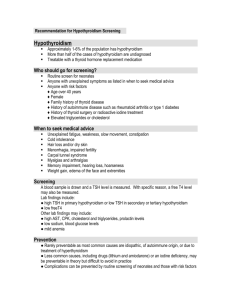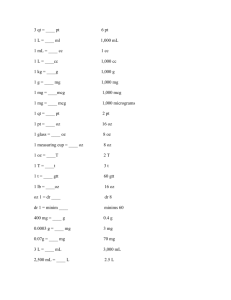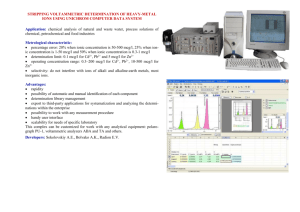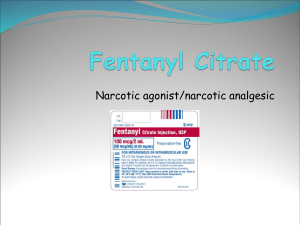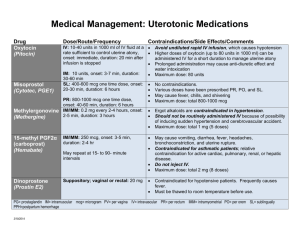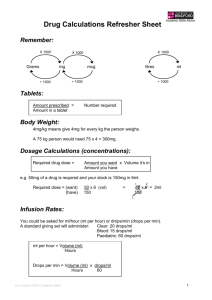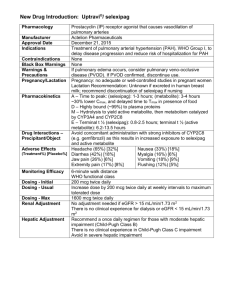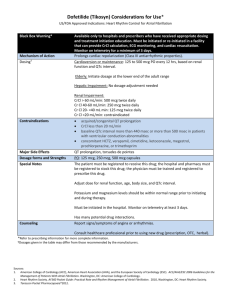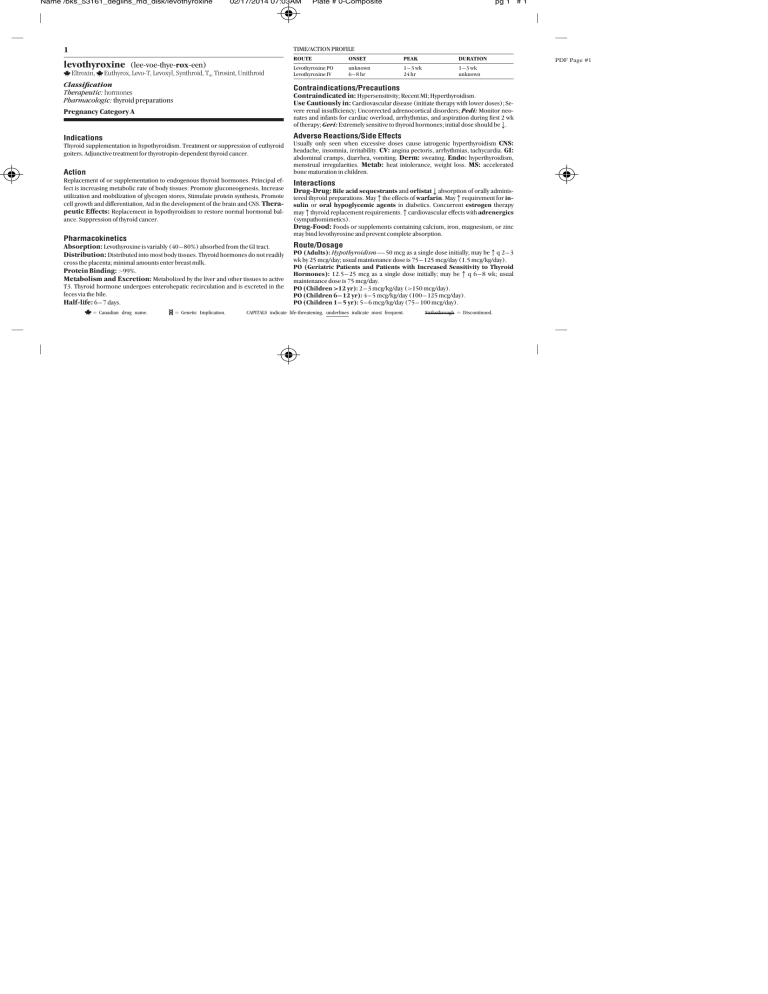
Name /bks_53161_deglins_md_disk/levothyroxine 02/17/2014 07:03AM Plate # 0-Composite pg 1 # 1 TIME/ACTION PROFILE 1 levothyroxine (lee-voe-thye-rox-een) Eltroxin, Euthyrox, Levo-T, Levoxyl, Synthroid, T4, Tirosint, Unithroid Classification Therapeutic: hormones Pharmacologic: thyroid preparations ROUTE ONSET PEAK DURATION Levothyroxine PO Levothyroxine IV unknown 6–8 hr 1–3 wk 24 hr 1–3 wk unknown Contraindications/Precautions Contraindicated in: Hypersensitivity; Recent MI; Hyperthyroidism. Use Cautiously in: Cardiovascular disease (initiate therapy with lower doses); Se- Pregnancy Category A vere renal insufficiency; Uncorrected adrenocortical disorders; Pedi: Monitor neonates and infants for cardiac overload, arrhythmias, and aspiration during first 2 wk of therapy; Geri: Extremely sensitive to thyroid hormones; initial dose should bep. Indications Adverse Reactions/Side Effects Thyroid supplementation in hypothyroidism. Treatment or suppression of euthyroid goiters. Adjunctive treatment for thyrotropin-dependent thyroid cancer. Action Replacement of or supplementation to endogenous thyroid hormones. Principal effect is increasing metabolic rate of body tissues: Promote gluconeogenesis, Increase utilization and mobilization of glycogen stores, Stimulate protein synthesis, Promote cell growth and differentiation, Aid in the development of the brain and CNS. Therapeutic Effects: Replacement in hypothyroidism to restore normal hormonal balance. Suppression of thyroid cancer. Pharmacokinetics Absorption: Levothyroxine is variably (40– 80%) absorbed from the GI tract. Distribution: Distributed into most body tissues. Thyroid hormones do not readily cross the placenta; minimal amounts enter breast milk. Protein Binding: ⬎99%. Metabolism and Excretion: Metabolized by the liver and other tissues to active T3. Thyroid hormone undergoes enterohepatic recirculation and is excreted in the feces via the bile. Half-life: 6– 7 days. ⫽ Canadian drug name. ⫽ Genetic Implication. Usually only seen when excessive doses cause iatrogenic hyperthyroidism CNS: headache, insomnia, irritability. CV: angina pectoris, arrhythmias, tachycardia. GI: abdominal cramps, diarrhea, vomiting. Derm: sweating. Endo: hyperthyroidism, menstrual irregularities. Metab: heat intolerance, weight loss. MS: accelerated bone maturation in children. Interactions Drug-Drug: Bile acid sequestrants and orlistatpabsorption of orally administered thyroid preparations. Mayqthe effects of warfarin. Mayqrequirement for insulin or oral hypoglycemic agents in diabetics. Concurrent estrogen therapy mayqthyroid replacement requirements.qcardiovascular effects with adrenergics (sympathomimetics). Drug-Food: Foods or supplements containing calcium, iron, magnesium, or zinc may bind levothyroxine and prevent complete absorption. Route/Dosage PO (Adults): Hypothyroidism— 50 mcg as a single dose initially; may beqq 2– 3 wk by 25 mcg/day; usual maintenance dose is 75– 125 mcg/day (1.5 mcg/kg/day). PO (Geriatric Patients and Patients with Increased Sensitivity to Thyroid Hormones): 12.5– 25 mcg as a single dose initially; may beqq 6– 8 wk; usual maintenance dose is 75 mcg/day. PO (Children ⬎12 yr): 2– 3 mcg/kg/day (ⱖ150 mcg/day). PO (Children 6– 12 yr): 4– 5 mcg/kg/day (100– 125 mcg/day). PO (Children 1– 5 yr): 5– 6 mcg/kg/day (75– 100 mcg/day). CAPITALS indicate life-threatening, underlines indicate most frequent. Strikethrough ⫽ Discontinued. PDF Page #1 Name /bks_53161_deglins_md_disk/levothyroxine 02/17/2014 07:03AM PO (Children 6– 12 mo): 6– 8 mcg/kg/day (50– 75 mcg/day). PO (Infants 3– 6 mo): 8– 10 mcg/kg/day (25– 50 mcg/day). PO (Infants 0– 3 mo or Infants at Risk for Cardiac Failure): 10– 15 mcg/kg/ day or 25 mcg/day; may beqafter 4– 6 wk to 50 mcg. IM, IV (Adults): Hypothyroidism— 50– 100 mcg/day as a single dose. Myxedema coma/stupor— 300– 500 mcg IV; additional 100– 300 mcg may be given on 2nd day, followed by daily administration of smaller doses. IM, IV (Children): Hypothyroidism— 50– 80% of the oral dose. NURSING IMPLICATIONS Assessment ● Assess apical pulse and BP prior to and periodically during therapy. As- ● ● pg 2 # 2 ● For patients with difficulty swallowing, tablets can be crushed and placed in 5– 10 2 ● ● Plate # 0-Composite sess for tachyarrhythmias and chest pain. Children: Monitor height, weight, and psychomotor development. Lab Test Considerations: Monitor thyroid function studies prior to and during therapy. Monitor thyroid-stimulating hormone serum levels in adults 8– 12 wks after changing from one brand to another. Monitor blood and urine glucose in diabetic patients. Insulin or oral hypoglycemic dose may need to be increased. Toxicity and Overdose: Overdose is manifested as hyperthyroidism (tachycardia, chest pain, nervousness, insomnia, diaphoresis, tremors, weight loss). Usual treatment is to withhold dose for 2– 6 days then resume at a lower dose. Acute overdose is treated by induction of emesis or gastric lavage, followed by activated charcoal. Sympathetic overstimulation may be controlled by antiadrenergic drugs (beta blockers), such as propranolol. Oxygen and supportive measures to control symptoms are also used. Potential Nursing Diagnoses Deficient knowledge, related to medication regimen (Patient/Family Teaching) Implementation mL of water and administered immediately via dropper or spoon; do not store suspension. IV Administration ● Direct IV: Reconstitute the 200-mcg and 500-mcg vials with 2 or 5 mL, respec- tively, of 0.9% NaCl without preservatives (diluent usually provided). Concentration: 100 mcg/mL. Shake well to dissolve completely. Administer solution immediately after preparation; discard unused portion. Rate: Administer at a rate of 100 mcg over 1 min. Do not add to IV infusions; may be administered through Y-tubing. ● Y-Site Incompatibility: Do not admix with other IV solutions. Patient/Family Teaching ● Instruct patient to take medication as directed at the same time each day. Take ● ● ● ● ● ● missed doses as soon as remembered unless almost time for next dose. If more than 2– 3 doses are missed, notify health care professional. Do not discontinue without consulting health care professional. Explain to patient that medication does not cure hypothyroidism; it provides a thyroid hormone supplement. Therapy is lifelong. Advise patient to notify health care professional if headache, nervousness, diarrhea, excessive sweating, heat intolerance, chest pain, increased pulse rate, palpitations, weight loss ⬎2 lb/wk, or any unusual symptoms occur. Caution patient to avoid taking other medications concurrently with thyroid preparations unless instructed by health care professional. Instruct patient to inform health care professionals of thyroid therapy. Emphasize importance of follow-up exams to monitor effectiveness of therapy. Thyroid function tests are performed at least yearly. Pedi: Discuss with parents the need for routine follow-up studies to ensure correct development. Inform patient that partial hair loss may be experienced by children on thyroid therapy. This is usually temporary. ● Do not confuse levothyroxine with lamotrigine or Lanoxin (digoxin). ● Administer as a single dose with a full glass of water, preferably before breakfast to Evaluation/Desired Outcomes prevent insomnia. ● Initial dose is low, especially in geriatric and cardiac patients. Dose is increased gradually, based on thyroid function tests. Why was this drug prescribed for your patient? ● Resolution of symptoms of hypothyroidism and normalization of hormone levels. 䉷 2015 F.A. Davis Company PDF Page #2
